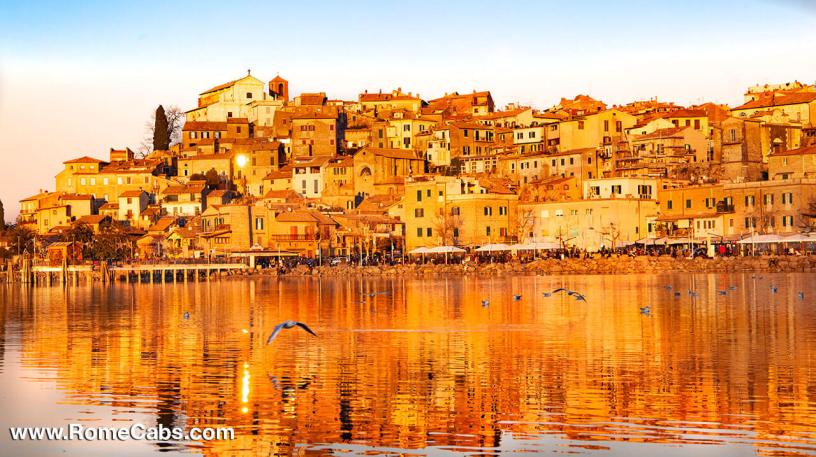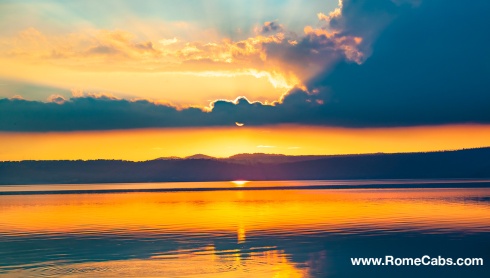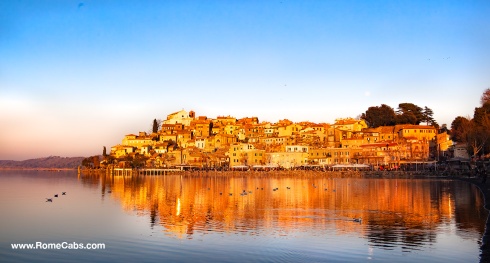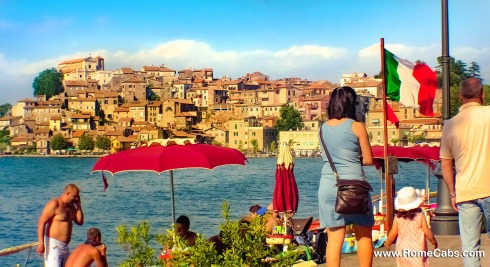Perched along the pristine shores of Lake Bracciano in the picturesque Lazio region of Italy, Anguillara Sabazia, often lovingly referred to as Anguillara, is a hidden gem that marries a rich history with breathtaking natural beauty. This charming lakeside town which is one of the most romantic villages near Rome, is a treasure trove of historical landmarks, tranquil promenades, and enchanting stories.
It’s no wonder that not only Romans flock to Anguillara on the weekends to enjoy its serene beauty, but Anguillara is also a popular destination for Countryside Pre Cruise Tours, Shore Excursions from Civitavecchia, and private tours in Italy from Rome.
First, let’s learn a bit about the famous lake upon which Anguillara sees its mirrored reflection.
.
Lake Bracciano – the tranquil lake oasis
.
.
Lake Bracciano, cradling the picturesque town of Anguillara on its shores, is more than just a body of water; it is a geological masterpiece with an intriguing history that dates back millennia. This volcanic crater lake is surrounded by stunning landscapes and, during the summer, becomes a magnet for sunseekers and beach enthusiasts from nearby urban hubs like Rome.
Lake Bracciano’s origins are rooted in the volcanic upheavals of Italy’s geological past. The lake occupies a massive caldera—a crater-like depression—carved by volcanic activity over half a million years ago. The volcanic complex of the Sabatini Mountains, where Lake Bracciano is nestled, experienced violent eruptions and explosions, leading to the creation of this unique natural wonder.
.
.
Anguillara – Medieval gem with Ancient Roots and Legends
.
Anguillara’s historical roots trace back to ancient times. While the town’s formal foundation date is not definitively documented, historical records and archaeological evidence suggest that the settlement has ancient origins.
Anguillara’s history traces back to the ancient formation of Lake Bracciano about 600,000 years ago. This prehistoric lake hosts three towns: Bracciano (with the famous Bracciano Castle), Trevignano, and Anguillara Sabazia.
Human presence by the lake dates back thousands of years, as evidenced by La Marmotta, the remains of an early Neolithic village situated just outside Anguillara Sabazia. This settlement, dating back to 5700 BC, was eventually submerged by the rising water levels caused by climatic changes.
The town of Anguillara Sabazia itself finds its origins in the 1st or 2nd century BC when a wealthy Roman citizen, Rutilia Polla, a member of the patrician class, owned a luxurious villa on the lake’s shores, now the site of the Church of Santo Stefano.
.
.
Anguillara’s unique name
The town’s unique name, Anguillara, is thought to have ancient Etruscan origins. It’s believed to be derived from “angui“, which means eels, as the town was once renowned for its eel fishing. While the history of this name may be debated, the association with eels is intriguing, and to this day, Anguillara is synonymous with delectable eel dishes, particularly during the annual Sagra dell’Anguilla, an eel festival celebrated with great enthusiasm.
The Etruscans, known for their sophisticated culture and advanced civilization, inhabited this region well before the advent of the Roman Empire. The association of Anguillara with eels implies that eel fishing and consumption were integral parts of the Etruscan way of life in this area. Eels from the nearby Lake Bracciano were not just a source of sustenance but also a significant aspect of the local economy.
.
The powerful Anguillara family of barons
The Anguillara family, of Norman origin, held considerable influence in Latium, particularly in Rome and the present-day province of Viterbo during the Middle Ages and the early Renaissance. It is likely that the family derived its name from the city of Anguillara Sabazia on Lake Bracciano, and the name may be linked to the Italian word for “eel” (anguilla) or possibly to a Roman villa Villa Angularia situated on a corner (Latin: angulum) of the Lake.
Count Ramone Anguillara, one of the family’s earliest known members, is associated with legendary conflicts with the Papacy. The family’s history includes figures like Gherardo, who allied with the Prefetti di Vico against the Roman commune in 1090, and later successors, such as John, who captured Santa Severa, and Niccolò, who conquered Tolfa in 1146. Pandolfo I, in 1186, initiated a protracted struggle with the Vicos for control of northern Latium and engaged with Henry VI, even hosting him in 1191.
Pandolfo II aligned with Henry’s son, Frederick II, during the siege of Viterbo in 1243 but was subsequently captured and imprisoned at Ronciglione, leading to the seizure of the Anguillara fief by Pietro di Vico. The family relocated to Rome and Capranica due to the shifting Papal seat to Avignon, where Orso dell’Anguillara, Senator of Rome, welcomed the poet Petrarch in 1336, solidifying their status as a prominent Roman family through alliances with the Orsini and Colonna families.
Orso was succeeded by Pietro, Dolce, and Everso II, a renowned condottiero who expanded their territories. Everso II’s son, Francesco, faced excommunication and imprisonment in Castel Sant’Angelo, leading to the loss of the family’s possessions to the Apostolic Chamber under Pope Paul II. Deifobo, Everso’s other son, eventually reclaimed their lands, which he held until his death in 1490. Pope Innocent VIII then assigned the Anguillara lands to his nephew Franceschetto Cybo.
The family’s final notable member was the condottiero Renzo da Ceri, who defended Rome during the Sack of 1527. The Anguillara family became extinct in the 18th century.
The town’s winding cobblestone streets, medieval buildings, and charming piazzas create a picturesque scene. Anguillara’s historical core is a mesmerizing labyrinth, with hidden corners and quaint squares that transport visitors to bygone eras.
.
Anguillara’s Lakeside Promenade
Anguillara’s lakeside promenade is undoubtedly one of the town’s crown jewels.
Lake Bracciano and the town of Anguillara, with their volcanic crater lake and enchanting lakeside promenade, offer not only a serene backdrop but also a captivating history. Anguillara’s lakeside promenade provides the perfect platform to admire the tranquil beauty of Lake Bracciano while connecting with the remarkable geological history that has crafted this breathtaking region.
.
Whether you’re an early riser embarking on a morning jog, a leisurely stroller seeking a peaceful afternoon, or a sunset chaser hoping to capture the sky’s magnificent transformation, the promenade provides an unparalleled front-row seat.
To capture breathtaking photos of Anguillara, take a walk along the lakeside promenade in the later afternoon during the “golden hour” for a postcard-perfect photo!
ALSO READ:
Visit Bracciano: Timeless Italian Jewel in the Roman Countryside
Top 7 Rome and Italy Travel Tips
Traveling to Italy this Summer? Don’t forget to bring THESE with you
.
Lakeside Beach of Anguillara
As the summer sun graces the region, the narrow beach along Anguillara’s lakeside promenade comes to life. It has become a sought-after destination for beach enthusiasts, primarily attracting visitors from neighboring big cities such as Rome. The tranquil setting and refreshing waters of Lake Bracciano offer respite from the urban heat and a serene escape from the bustling city life.
.
.
One of the most eye-catching features of the beaches surrounding Lake Bracciano is the presence of black sand. This striking phenomenon is a direct result of the region’s volcanic history. Over time, the relentless erosion of the dark volcanic rock and ash in the surrounding landscape has deposited fine black particles into the lake’s shores. This distinctive black sand not only adds to the aesthetic appeal but also reminds visitors of the geological forces at play.
Whether a day tour from Rome or a day trip from Civitavecchia, consider a stop in Anguillara in your itinerary for your next trip to Italy.




